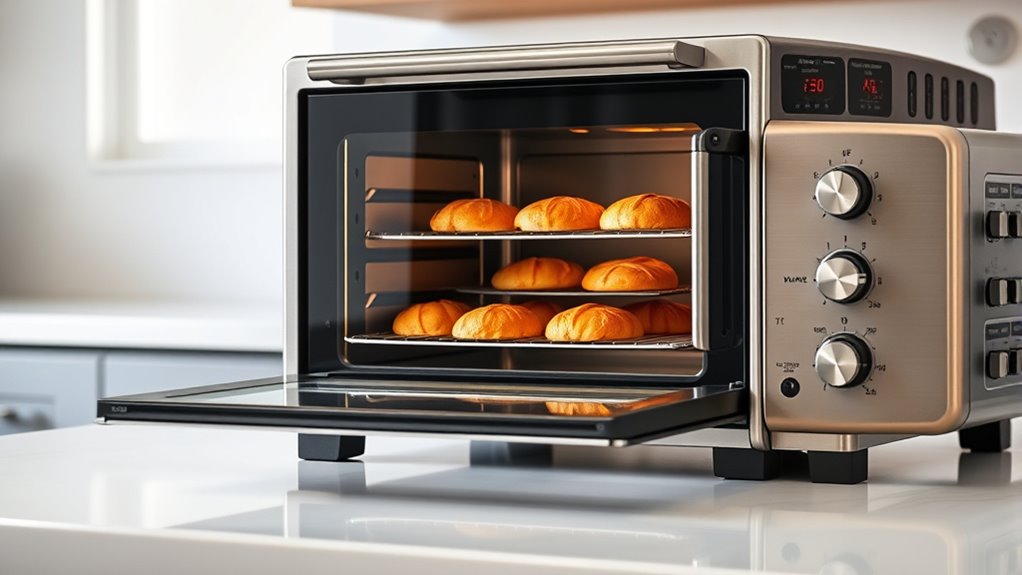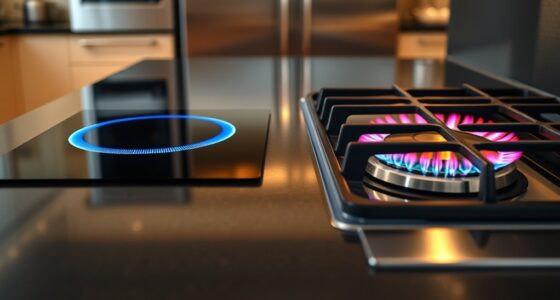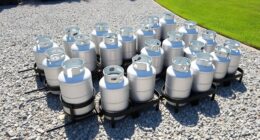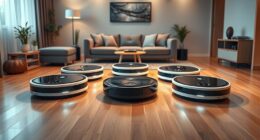Convection ovens use a fan and exhaust system to circulate hot air, cooking food faster and more evenly than traditional ovens, which rely solely on radiant heat from fixed elements. This means you get crispy, evenly browned results with less time and energy. Traditional ovens are simpler but may require more attention for even cooking. To discover how these differences can suit your culinary habits and kitchen, explore further insights below.
Key Takeaways
- Convection ovens circulate hot air with a fan for even, faster cooking, while traditional ovens rely on radiant heat from elements.
- Convection ovens typically cook food more quickly and efficiently, reducing energy use over time compared to traditional models.
- They excel at roasting, baking pastries, and achieving crispy, evenly browned results; traditional ovens may need adjustments for even baking.
- Convection ovens offer advanced features like adjustable airflow and temperature controls, unlike basic traditional ovens.
- Convection ovens are ideal for frequent bakers seeking versatility and efficiency; traditional ovens suit simple cooking needs.

When choosing between convection ovens and traditional ovens, understanding their key differences can help you make the best decision for your cooking needs. One of the main distinctions lies in how they distribute heat, which directly impacts baking efficiency and energy consumption. Convection ovens incorporate a fan and exhaust system that circulate hot air evenly around your food. This circulating air promotes uniform cooking, so baked goods and roasts cook more evenly and often faster than in traditional ovens. Because of this, you can expect to reduce cooking times, which enhances your baking efficiency. Less time in the oven means you’re saving energy, making convection ovens a more energy-efficient choice overall. Additionally, convection ovens are typically equipped with advanced features that allow for greater control over temperature and airflow, further optimizing cooking results.
Convection ovens cook faster and more evenly, saving time and energy compared to traditional ovens.
Traditional ovens, on the other hand, rely solely on radiant heat from the heating elements located at the top and bottom of the oven cavity. The heat distribution tends to be uneven, often requiring you to rotate pans or adjust racks midway through cooking to achieve consistent results. This uneven heat can lead to longer cooking times and sometimes uneven baking or browning, which might make your recipes less predictable. While traditional ovens may consume less energy per use initially, they sometimes require longer cooking periods, which can offset the energy savings. In contrast, convection ovens’ faster cooking times and even heat distribution translate into lower overall energy consumption over multiple uses.
Another factor to weigh is how each oven handles different types of food. Convection ovens excel at roasting meats, baking pastries, and toasting because their consistent heat and airflow produce crispy, evenly browned results. Traditional ovens are still effective but may need extra attention to achieve similar outcomes, especially with baked goods that require gentle, even heat, like cakes and delicate pastries. For versatility, convection ovens often come with adjustable settings, allowing you to switch between convection and conventional modes, giving you more control and flexibility.
You should also think about your cooking habits and kitchen space. If you bake frequently and want faster, more energy-efficient results, a convection oven could be a worthwhile investment. However, if you mostly bake simple recipes or prefer a more straightforward appliance, a traditional oven might meet your needs without the added features. Ultimately, understanding how each oven type performs in terms of baking efficiency and energy consumption will guide you toward the option that best fits your lifestyle, budget, and culinary preferences.
Frequently Asked Questions
Do Convection Ovens Use More Energy Than Traditional Ovens?
Convection ovens generally use less energy than traditional ovens because they cook faster and distribute heat more efficiently. This lower energy consumption reduces your environmental impact and saves you money on utility bills. Since they heat up quickly and cook evenly, you spend less time running the appliance. Overall, choosing a convection oven can be a more energy-efficient option, making it better for both your wallet and the environment.
Are Convection Ovens Suitable for Baking Delicate Pastries?
If you’re aiming for pastry perfection and delicate baking, convection ovens can be a good choice. They circulate hot air evenly, which helps achieve consistent results. However, for very delicate pastries like soufflés or certain tarts, you might prefer a traditional oven to prevent over-baking or uneven heat. Overall, convection ovens are versatile, but for the most delicate baked goods, you should monitor closely and adjust settings as needed.
Can I Convert My Traditional Oven Into a Convection Oven?
Imagine starting new culinary possibilities—yes, you can explore oven modifications to achieve a convection conversion. While most traditional ovens lack a built-in fan, you can add a fan kit or consider professional upgrades to mimic convection baking. This transformation brings a new level of heat circulation, enhancing your cooking experience. Just remember, some ovens may need more extensive modifications, so weigh your options before beginning on this flavorful journey.
How Does Cooking Time Differ Between Convection and Traditional Ovens?
You’ll find that cooking time generally decreases in convection ovens because their better heat distribution boosts baking efficiency. The fans circulate hot air evenly around your food, cooking it faster than traditional ovens. So, when using a convection oven, expect shorter baking times and more consistent results. Keep an eye on your dishes, as they may cook quicker, saving you time without sacrificing quality.
Are Convection Ovens More Expensive to Operate Long-Term?
Imagine your kitchen as a battleground where energy costs and maintenance expenses fight for your wallet. Convection ovens, with their efficient fans, often use less energy, saving you money over time. While they may have higher upfront costs, their faster cooking reduces energy consumption, and maintenance expenses are similar to traditional ovens. So, long-term, convection ovens can be more economical, making them a smart investment for your culinary battles.
Conclusion
So, picture yourself pulling a perfectly golden roast from a convection oven, the aroma swirling around you like a warm embrace. Unlike traditional ovens, convection models use fans to evenly circulate heat, making every dish a masterpiece. Whether you crave the even crispness or the nostalgic charm of classic baking, understanding these differences helps you choose the right tool. With either oven, your culinary creations will always feel like a warm, inviting invitation to savor.









